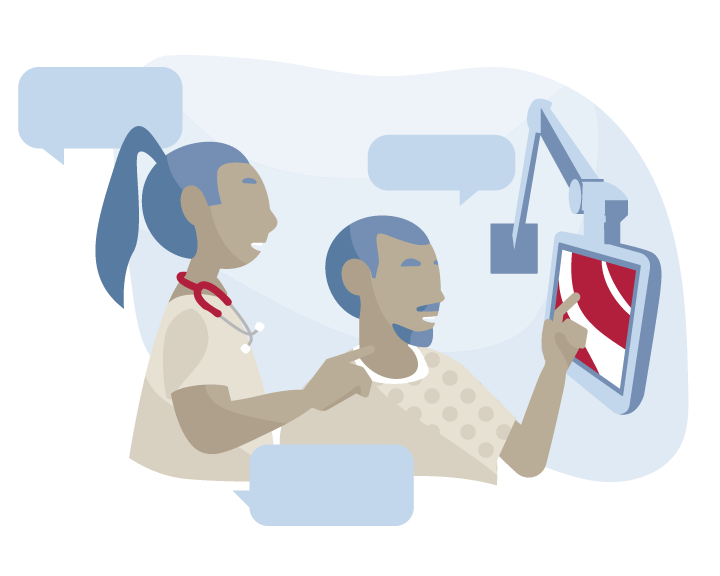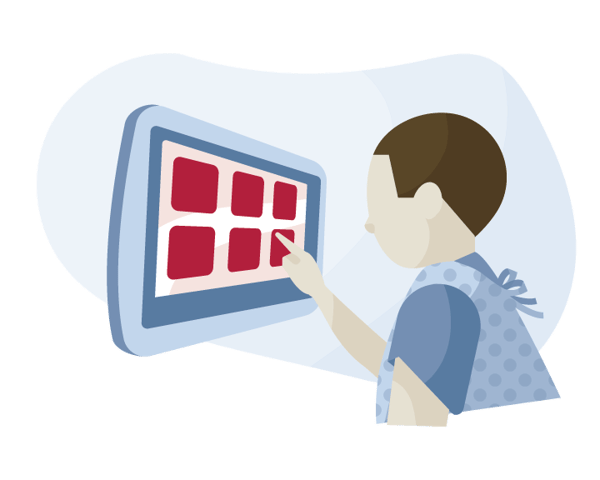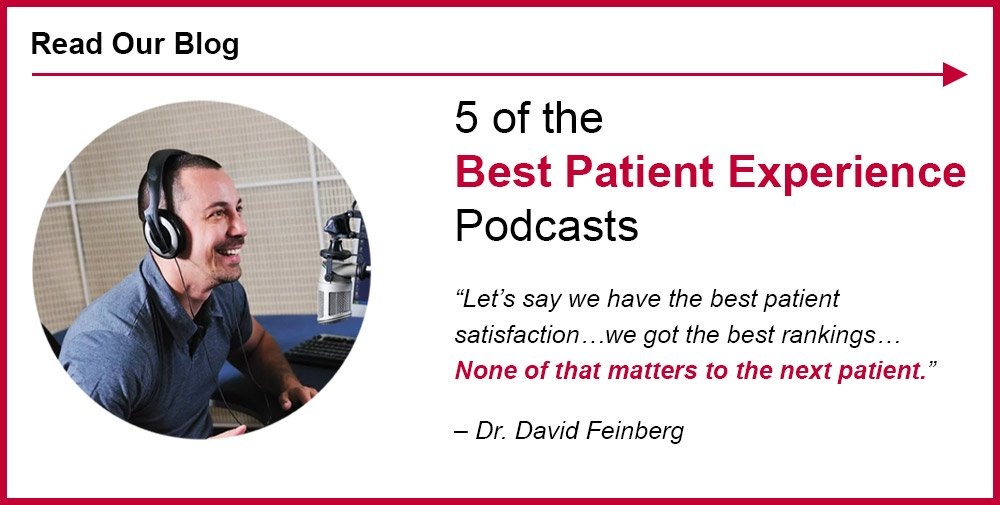What is the Patient Experience?
Discover how we all play a role in the comfort and safety of your patients
Healthcare truly takes a team to deliver the best experience to patients. Learn more about how facilities are prioritizing the patient experience and shifting their process toward a human-centric view.

According to the Institute of Medicine, healthcare needs to be “safe, effective, patient-centered, timely, efficient and equitable” (Institute of Medicine, 2001, pp. 39-40). The Beryl Institute defines the patient experience as “the sum of all interactions, shaped by an organization’s culture, that influence patient perceptions, across the continuum of care” (Wolf, 2021). There are about as many definitions as there are sources and institutions that discuss the patient experience.
Healthcare facility designers and managers, patient experience officers, nurse managers, doctors, clinicians, IT teams and everyone involved in the healthcare process all must consider their impact on the patient experience. The patient experience begins long before a patient sets
foot in a healthcare facility, and even before their first point of communication.
The patient experience begins when architects design facilities, when clinicians are hired and when marketing professionals create messaging. All departments need to keep the patient experience in mind and ensure that the work they are doing enhances that experience.
Table of Contents
How Does Safety Impact the Patient Experience?
Since the COVID-19 pandemic, patient safety has taken on an even more robust meaning and greatly added to the burden on healthcare staff’s daily routines. The pandemic has been a reminder that not only is patient safety critical to the overall patient experience, but that patients have a perception of the safety that is provided and will provide feedback on what they think goes well and doesn’t go well with their safety.
The Beryl Institute’s 2021 The State of Patient Experience Survey found that hospital personnel and consumers believe patient experience should include patient safety to a great extent, and it is one of their top three measures of patient experience. Healthcare facilities must consider
safety and integrate it with the other measures that affect patient experience such as quality outcomes, customer service, employee engagement and more (Wolf, 2021).
Despite being critical, patient safety is a vast and sometimes overwhelming topic, as it means different things in different scenarios. It can refer to fall prevention, avoiding medical errors or technological safety in a patient room. Therefore, it’s important to consider many angles and scenarios when planning to manage risks. You can be creative in coming up with ways to improve both safety and the patient experience.
Fall prevention, for example, often requires input and support from many different care providers, and patients need to understand it, too. Often patients need to receive this information as soon as possible.
However, they may also prefer to review it once they’re settled in an acute care space. For the busy nursing staff, finding the time to re-communicate this information can be difficult. Instead, facilities can provide a link to a video on a television or tablet near the bedside that patients can watch at their leisure. This helps patients feel more independent while also keeping them safe.

Speaking of televisions, it’s critical that your facility uses UL-Listed, healthcare-grade televisions.
They’re designed for infection control and to safely be powered on much longer than consumer or commercial televisions. Smaller, more personal healthcare televisions and tablets are designed to be low voltage or powered over ethernet. This keeps patients safe from the risk of shock, even if they have an IV break in their skin.
How Do Effective Communications Improve the Patient Experience?
Communication is one of the most important elements of the human experience, so it is fitting that it applies to the patient experience as well. We communicate to share our story and to understand someone else’s story. The same is true in healthcare. Patients communicate their
health stories, and providers must communicate information such as treatment plans back to patients.
Making communication effective for healthcare providers typically means making it efficient and convenient. Clinicians often have incredibly busy schedules with many patients. In addition, the
American Association of Colleges of Nursing (2020) projects a nursing shortage as Baby Boomers age and need more access to healthcare and nursing schools struggle with the increasing capacity of students.
The easier the communication is, the better the patient experience.
Technology is now a driving force of communication between healthcare providers and their patients. By providing easy access to relevant,
real-time information and education that nurses and clinicians can reference, you can improve the effectiveness of their communication with patients.
Forbes’ article about technology improving the patient experience shows how technology has opened up provider-patient communication, reduced medical error potential, increased access to care, and more (Cooper, 2019).
Additionally, healthcare communication has evolved tremendously in the last year and a half with more providers offering telehealth services. Many providers had to begin seeing patients virtually with the onset of the COVID-19 pandemic and the differing needs of patients. Right as the
pandemic began in America in March 2020, it was reported that 65.6 percent of Americans had a lack of trust in telehealth care. However, when Americans were surveyed again a year later, 87.82 percent of Americans said they wanted to keep using telehealth care after the pandemic ends (Adams, 2021). This shows that not only are patients fond of telehealth options, they are beginning to expect that it will be offered when a provider can safely do so.
Why Is Transparency Important in Communication Between Patients and Care Teams?
Perhaps the biggest call for transparency in healthcare is for price transparency. Healthcare is becoming more like a consumer experience, and providers now must provide “shoppable” prices on-demand and online for their health services under the Centers for Medicare & Medicaid Services’ hospital price transparency rules. The goal of this plan is to allow for patients to be better prepared for their spending and to shop and compare prices across hospitals (Centers for
Medicare and Medicaid Services, 2021).
Not only is price transparency relevant now in healthcare, but consistent and transparent messaging is important for creating a good patient experience. Consistent, effective communication between healthcare providers and patients ensures that patients receive the right information. It also empowers the patient and reassures them that they understand what’s happening. Sometimes a doctor can tell a patient one thing, and then the next nurse that comes in says something different.
This confusion can lead to doubt and anxiety for the patient. Because this scenario would hurt the patient’s experience, it could also lead to lower Hospital Consumer Assessment of Healthcare Providers and Systems (HCAHPS) patient satisfaction scores.
Conversely, when each healthcare provider gives the patient the same information, patients feel more confident in their care. It’s also important for care teams to not only tell but also demonstrate to patients that they are there to answer any questions. Clinicians can improve communication using digital bedside technology to answer their questions in advance.
How Does Digital Technology Impact Patient Education?
As technology advances for consumers, it’s also advancing in the healthcare sphere, and popular tech trends can often overlap. Even YouTube has partnered with several healthcare organizations to better provide access to credible medical information (Jercich, 2021). Whether
your facility subscribes to leading patient education video content or has customized your own educational videos to help patients understand more about their health condition and treatment, or you’d rather just show a pre-op or post-op video you found on YouTube, video is engaging to patients. In general, people enjoy consuming video; reporting that they watch an average of 18 hours of videos online each week, which has increased 7.5 hours over each week within the last 3 years (Wyzowl, 2021).
A great way to use a digital solution to engage patients and improve education is to use it to deliver discharge instructions. Some facilities give their patients stacks of papers full of discharge instructions, and while this is well-intentioned, technology can help. By using technology to convey the discharge instructions, you can ensure interaction with the patient. For instance, patients may have to scroll to the bottom of the page to sign, or even answer a question, before they can move on to the next page. You can also easily send a copy to the patient via email. This way, the patient has an electronic resource to be able to easily search for answers to their questions.
LET's BUILD CONNECTIONS
Stay Up to Date
Subscribe to our Connections blog. We talk about the patient experience through the lens of many types of roles and facilities.

My brother has MS and PDi was extremely compassionate in helping me get the equipment I needed as quickly as I needed it.
PDi medTV User
Let’s take extensive EHR requirements as an example. Electronic health records can be time-consuming, and it can be convenient to be at the computer inputting data while talking to the patient. However, this can sometimes make patients feel as though they’re not getting their
provider’s full attention. By taking steps to put the patient first and finding ways to make EHR’s less time-consuming, you can make your hospital more patient-centric (Haas et al., 2019).
Children’s hospitals often provide great patient-centered care, even simply in the design of the spaces. With interactive play areas, fun decorations in patient rooms and intelligent use of technology, the sterile hospital space can become more family- and patient-centric.
Offering patient-centered care through thoughtful design of patient space also helps patients feel comfortable, empowered and engaged in the care process. This often comes from increased communication with their care team, as we mentioned earlier. By taking the time to listen to
patients and respond thoughtfully, you can show them that you truly care about their thoughts and about them as a person. This leads to patients and families leaving better satisfaction scores for their providers (NEJM Catalyst, 2017).
What Is Designing for Patient Comfort?
Hospitals and other healthcare facilities need to provide an optimal healing environment for patients. This often begins in the design stage, and it’s critical that healthcare architects and medical equipment planners consider how their design choices will impact patients. One of the biggest problems for patients, and therefore healthcare providers, is too much noise.
This is why the Hospital Consumer Assessment of Healthcare Providers and Systems (HCAHPS) has noise-related questions in their survey: because it is a major contributing factor to a patient’s experience (Centers for Medicare & Medicaid Services, Baltimore, MD, 2021).
Between beeping machines, the commotion of people walking by and the television two rooms over that’s playing on maximum volume, it can be hard to find peace and quiet in a hospital, even if you’re using a relaxation app.
With smart design choices, and the ability to get real-time patient feedback, your facility can avoid or lessen the impact of noise on the floor. Choosing personal hospital televisions can be a great solution. Patients can move the device nearer so they don’t need the volume as loud, or they can use headphones for a fully personalized experience.

Healthcare-grade patient televisions offer volume limiters as well. Interactive patient software on bedside tablets can allow patients to submit real-time feedback—such as the noise level is
too high—so nurses and other staff can act immediately to rectify the situation and improve the patient experience (Boulton, 2016).
Patient spaces can be as unique as the facilities themselves. Because of this, technology and its accompanying TV hardware cannot be a one-size-fits-all solution. Some patient spaces might need a traditional wall mount TV, while others would benefit from a floor or ceiling mount TV.
Specialized departments like cardiology need a high-tilt mount TV where patients can lie flat on their backs, whereas facilities undergoing renovations may want a horizontal boom mount. A space-saver patient TV solution works great in infusion pods or half-height walls. For more
information on different types of mounts, head to our blog and learn the nine ways to mount your personal patient television or patient tablet.
Patient comfort and satisfaction are integral to the success of a healthcare facility. Take time during the design phase to put technology, such as healthcare-grade televisions, and processes into place that can help solve these problems before they occur.
How Can Hospitals Use Technology to Improve Timeliness?

Having to wait while you’re sick or in pain can be excruciating. To provide an excellent experience, make the time between when a need is recognized and when care is given as short as possible. When urgent-care facilities become busy, care can sometimes be delayed, especially for those with the least-pressing needs. This can lead to a negative patient experience.
When there are long delays, mobile TV carts can provide a distraction for waiting patients. Sometimes you need to entertain patients in non-standard locations, such as overflow areas or rooms that don’t have patient-facing technology. One of the easiest ways to do this is with a
mobile TV cart. Whether you give patients access to television, games, relaxation programming or even the Internet, providing a welcome distraction can help their wait time feel shorter. This, in turn, can help improve their experience.
Decreasing wait times is a difficult task, but the industry is beginning to make it easier with the growth of telemedicine. Virtual visits can be a great solution in certain cases and allow for benefits such as facilities offering shorter wait times and serving more patients (Emerson, 2018).
Telehealth visits, often adopted by millennials, bring the care to the person at their home and should be considered as part of a provider’s strategy to some degree (Sanborn, 2018). In fact, the Beryl Institute says that virtual appointments and consultations are the top digital approach
used right now to improve patient experience in 2021 (Wolf, 2021).
By providing a telehealth option for your patients, you can improve their perception of your healthcare facility and increase their quality of care, too. Telehealth can also help providers offer remote monitoring for patients with chronic conditions.
Remote patient monitoring allows for patients to increase personal engagement in their care and allow for providers to see the patient’s health in a bigger picture with more consistent data coming in (The Center for Connected Health Policy, n.d.)
According to the Beryl Institute, hospital workers and consumers surveyed in 2021 feel that innovation and technology influence patient experience outcomes at 53%, which is up 9% from 2019. Technology continues to be a factor in patient experience ratings and will continue to be a factor even after the COVID-19 pandemic. Integrating technology with healthcare is not a new concept, but it is still important to healthcare facilities and their patient experience ratings (Wolf, 2021).
What Is the Patient Experience for At-Home Care or Care Closer to Home?

Patients need care as soon as possible, and when telehealth isn’t an option, smaller clinics can provide patient care versus patients traveling to large hospitals, urgent care centers, and emergency rooms. There is a growing trend in the industry to bring healthcare closer to home. In
some cases, that actually means bringing care into the home.
For example, home hemodialysis has recently increased in popularity. In fact, 62,000 people in the United States were dialyzing at home as of 2017 (Weinhandl, 2020). Home therapies in general, not just dialysis, are a great way to encourage people to follow through on their healthcare plans. Sometimes getting to appointments is difficult for patients. By providing an option like home therapy or telemedicine, you can remove that barrier and improve patient access to care.
Micro-hospitals are another growing trend in healthcare. These small inpatient facilities offer many services on a smaller scale, conveniently located near patients’ homes. Often affiliated with large health networks, they make care easier to access and cost effective (Heath, 2018).
Another option is available for patients who don’t want to have procedures done in the hospital. In many cases they can instead choose to visit an ambulatory surgery center (ASC). These physician-owned centers improve the patient experience with decreased wait times, improved quality and better scheduling options. ASCs focus on providing their patients with the best possible surgery experience.
How Can IT Departments Contribute to a Better Patient Experience?
It can seem like the healthcare journey takes a lot of time. The process of making an appointment, then actually receiving care and follow up care to finally completing care plans takes a very long time. When people think of the word “efficient,” the word “healthcare” may not be the first industry to come to mind. In fact, some people may think efficiency and healthcare are opposites, but many facilities are doing a lot with technology to change these perceptions.
One way to plan for more efficiency is to ensure there are consistent flows of information, education and entertainment for patients throughout their healthcare journey. Healthcare TVs can be used to safely display consistent communication to patients. For example, a facility could use large screen TVs in waiting rooms to display information about the facility and providers, then when patients go back to the exam rooms, smaller, personal patient TVs could be used to show the facility’s educational content and more. This helps patients feel calm and confident in their care.
Patients also want efficient and easy access to their entertainment while in the hospital. One way to meet these needs is to have the devices conveniently located at the patient’s bedside. In other cases, patients would need to ask a nurse or aide to bring them a tablet or other device
in order to distract themselves. With a bedside-mounted touch screen TV/tablet, patients can watch TV, play games or browse social media without needing to call their nurse.
Hospitals and their IT departments have options to help improve their efficiency beyond patient entertainment, as well. Many electronic health record (EHR) platforms can automate many manual processes. For example, when patients complete forms electronically, the forms are
automatically analyzed and stored for future use, without taking time from the staff.
There are other automation tools that healthcare providers can explore. Nurses and aides are often incredibly busy, working hard to ensure their patients have everything they need. Sometimes it might be helpful for patients to communicate their needs more effectively to their
caregivers. By investing in the right technology, you can solve this problem and better connect patients and their providers and allow them to communicate more effectively (Science Buzz, 2021).
Technology is being used to supplement a great patient experience, not to replace it.
This can make the most of the staff member’s time, as they can know what the patient needs before they even enter the room. This also allows for patients to be more engaged and active in their care. Technology and automation can also be used for messaging with patients or payment
processing, which can save staff time and improve revenue collections.
What Do Healthcare IT Managers Worry About Most with Connected Technology?

Data security certainly makes up a significant part of any healthcare IT department’s costs and risk assessments. Anyone in healthcare has HIPAA concerns because healthcare organizations manage a significant amount of personal patient health information. IT departments are often in control of this data, and any software they invest in and implement needs to protect that information.
Electronic health records (EHRs) contain perhaps the most sensitive pieces of information. As EHRs become more widespread, IT departments are tasked with protecting them in an ever-changing world of information security and encryption. Over half of healthcare organizations are investing in health IT as more and more devices become connected to the Internet, thus exposing EHRs to security risks.
Integrated technology has not yet been perfected for healthcare use, although it is an excellent tool for providers. Early healthcare innovations like artificial intelligence (AI) cannot take the place of a clinician to deliver a diagnosis to a patient through an electronic health record system. But the benefits of AI can help care providers focus on the patient experience (Kaushal et al., 2019). IT managers in healthcare have different concerns with connected devices and the Internet of Things (IoT).
The more devices that are connected, the more devices need to be protected.
As hackers become smarter and more skilled, they will find new ways to enter a system through an unprotected device. When protecting highly sensitive information like a patient’s medical records, IT managers are rightfully concerned about cybersecurity breaches (Jercich, 2021).
Ransomware attacks are increasing, and that trend is likely to continue upwards. Simultaneously, cybersecurity in healthcare will also likely become stronger (Department of Health & Human Services, 2021). When implementing an integrated solution in a medical space, IT managers want to know that it is safe and secure enough to keep patients’ private information and medical devices safe.
Integration of Care for Patient Continuity
When patients move from one hospital to another or from a hospital to a rehab center or nursing home, it’s important that those transitions are smooth. Healthcare providers can use digital technology integration to improve the patient experience in a meaningful way across the continuum of care. Healthcare providers often collect a lot of data from their patients, and it’s important that they focus on data interoperability, which is the goal to improve patient care through better electronic reporting to public health (Centers for Disease Control and Prevention,
2021). From test results to patient interviews, health records contain a large amount of sensitive information.
Patients can often become frustrated if they repeat the same information to provider after provider.
Digital media solutions can give healthcare practitioners a way to quickly review a patient’s information before seeing them. This can help the patient feel seen and improve their patient experience. This is especially important when patients are moving from one facility to another to ensure that nothing is lost.
Data interoperability allows patients to combine their health information from multiple providers and ensures they are understood and have people accountable for their care. The Centers for Medicare and Medicaid Services’ meaningful use rule, also called promoting interoperability, has been updated throughout the 11 years it has been in place to make it more useful for patients. Updates include requirements for electronic capture of clinical data, meaningful use of electronic health records for quality, using certified electronic health record technology to improve health outcomes, and more (Centers for Medicare & Medicaid Services,
2021).
What Impact Does Technology Have on Equitable Access to Healthcare for Patients?

Equitable access to healthcare has been an important factor since before 2001 and continues to be one of the rising commitments in 2021, according to the Beryl Institute (Wolf, 2021). All patients deserve to be given equal quality healthcare, but this still doesn’t always happen. While there have been changes, there is still progress to be made. According to the National Center for Health Statistics, in 2019, the percentage of uninsured people ages 18-64, who are classified as
“poor” or “near poor” were much higher than those who were considered “not poor” (Centers for Disease Control and Prevention, 2020).
Providers can use technology to assist them with providing care to all patients and break down the barriers that may limit their access to receiving care. One of the easiest ways that technology can make a difference is by providing translation services for patients whose primary language is different from their providers. With the right technology, patients and providers can use video-conferencing software to have an interpreter present to ensure that the patient can understand and be understood.
Aside from the actual care itself, patient entertainment is a major factor in the patient experience.
Depending on their condition, some patients cannot control a TV, whether the control is a pillow speaker, a typical remote or even a touchscreen device. Instead, these patients might need accessibility solutions such as a sip-and-puff solution to control the TV. By providing this option, you can give access to the same entertainment to all of your patients.
When talking about health equity, we would be remiss if we didn’t mention social determinants of health. Even if all hospitals truly provided equitable care to every patient, changes still need to be
made outside of those four walls. When people live in physical and social environments that are more harmful than helpful to their health, no amount of care in a hospital can fix it. Full health equity comes from addressing and making changes to these social determinants (Office of
Disease Prevention and Health Promotion, 2020).
Access to Care for Chronic Care Patients
Access to healthcare for patients with chronic conditions can be a major concern. While there have been some changes, as we previously mentioned, to improve insurance coverage for those with preexisting conditions, advancements are still needed. Recently there has been plenty of news coverage about the rising cost of insulin (Kumok, 2021). Insulin is a necessity for the approximately 1.4 million American adults who reported having type 1 diabetes and using the drug (Centers for Disease Control and Prevention, 2020). Because of these increases, many patients are sadly rationing this life-saving medication.
Access to care goes beyond being able to make an appointment and see a doctor. The need for health equity includes ongoing treatments, such as dialysis, chemo or other infusion treatments over a set period of time, or lifelong medicines, such as insulin. When it’s hard to receive care or
too costly to purchase a critical drug, the patient experience becomes increasingly negative, and it takes a lot of work to rebuild that trust and support.
Background on Patient Rights
The Patient Care Partnership is a replacement for the American Hospital Association’s Patient’s Bill of Rights. This document outlines what patients should expect when they stay at the hospital regarding their rights and the hospital’s responsibilities. Any patient can ask for a copy
of the partnership when they enter a hospital and should be given a brochure outlining their expectations. These include high-quality care with personal involvement, a clean and safe care environment, protection of privacy and help to leave the hospital and with billing (American Hospital Association, n.d.). outlining their expectations. These include high-quality care with personal involvement, a clean and safe care environment, protection of privacy and help to leave the hospital and with billing (American Hospital Association, n.d.).
Following the passage of the Affordable Care Act in 2010, there have been additional patients’ rights implemented in regard to insurance. These include being able to receive coverage for preexisting conditions and keeping children as dependents until age 26 (Centers for Medicare &
Medicaid Services, 2021). One of the most important patient rights is informed consent. Under this right, a healthcare provider must give a patient as much information as they need to make a decision about their care (American Medical Association, n.d.).
Conclusion
PDi pulls on multiple definitions to fully capture the essence of the patient experience. Considering the Beryl Institute’s definition, we use the six facets outlined by the Institute of Medicine to define the patient experience. Here, we’ve looked at how each of these elements
plays a role in developing meaningful, integrated solutions to deliver the ultimate patient experience.
The patient experience is made up of many facets and it means something a little different to just about everyone. An integrated approach from many perspectives will help you deliver the ultimate
patient experience. Providing an excellent experience to patients begins with remembering that they are people first, patients second. By treating the person before the patient, you can make a lasting impression and impact, as well as provide a positive experience.








